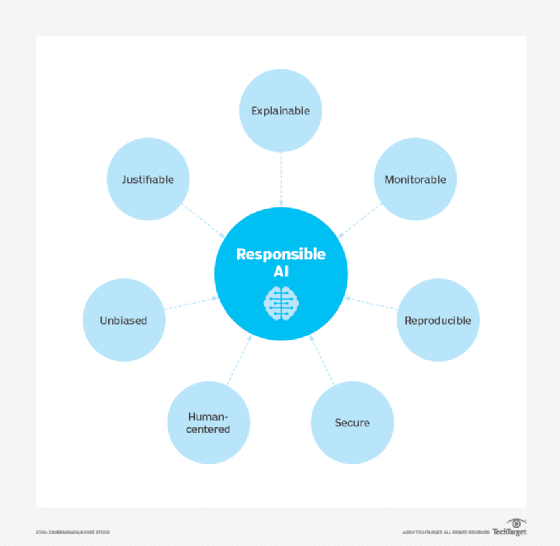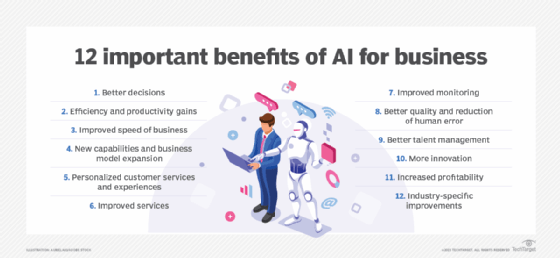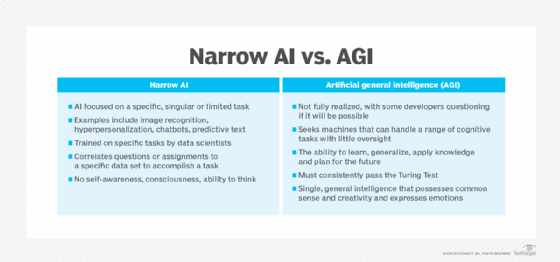
What is artificial superintelligence (ASI)?
Artificial superintelligence (ASI) is a hypothetical software-based system with intellectual powers beyond those of humans across a comprehensive range of categories and fields of endeavor. An ASI system has yet to exist and is only currently theoretical.
Regular artificial intelligence is increasingly a part of our everyday lives in systems such as virtual assistants, expert systems and self-driving cars. Nevertheless, AI technology is in its early days of development. Systems vary in their abilities, but all current ones are examples of weak or narrow AI. They are high-functioning systems that replicate and even surpass human intelligence, but only for specific defined purposes. To be considered ASI, a model would need to excel beyond human ability at a range of tasks at a very high level.
ASI is also known as super AI or superintelligent AI. Theoretically, ASI's superior capabilities would apply across many disciplines and industries, and would include cognition, general intelligence, problem-solving abilities, social skills and creativity.
Scientists think the first step in developing superintelligent technology is to establish artificial general intelligence. AGI is an AI system that can perform any task a human can with the same capabilities. Some AI programs exist that are superior to humans in one cognitive domain, such as the chess computer program Fritz. However, no superintelligent programs are available today that are superior to humans in every capacity.
This article is part of
What is enterprise AI? A complete guide for businesses
The intention behind ASI is to surpass human cognitive capacity, which is held back by the chemical and biological limits of the human brain. ASI would have applications in many fields, including science, finance, business, healthcare, agriculture and politics. However, developers and researchers have not yet demonstrated ASI capabilities. Many experts are skeptical that it ever will exist. Experts have also raised concerns that it could pose a threat to humanity.
The theoretical future creation of superintelligent supercomputers and other systems is sometimes referred to as the technological singularity. In that scenario, one potential outcome is the addition of superintelligence to the human brain.
How to achieve artificial superintelligence
The creation of ASI is a highly theoretical and complex topic. Because it hasn't been achieved yet, AI researchers don't know exactly how ASI will be built. Its creation will require significant advancements in AI technology and the achievement of AGI. However, many researchers believe that the creation of ASI is inevitable.
The creation of ASI depends on the continuing innovation of existing AI capabilities in the following technologies:
- Large language models. These language models use natural language processing (NLP) algorithms to replicate natural human language. Models such as OpenAI's GPT-4 and Google's BERT can summarize textual data, converse with humans, generate essays and create visualizations from simple prompts. ASI will need these types of models to converse and generate content.

- Multimodal AI. Deep learning models such as NLP, computer vision and acoustic models are mapped to only one type of data. Multimodal AI applications combine visuals, text, speech and other data types. For instance, OpenAI's technology can generate images based on a user's text prompts. ASI would need to be able to combine all modalities.
- Neural networks. Neural networks are a type of deep learning software based on the operation of neurons in the human brain. These networks process and operate multiple functions in parallel or in arranged tiers. By emulating human brain operations, AI researchers hope to eventually achieve human cognition levels in neural networks and then evolve those capabilities even further.
- Neuromorphic computing. This approach uses hardware that is based on the neural and synaptic structures of the human brain. Neuromorphic computers generate more compute power than traditional computers and neural networks. They also can process and store data on the same neuron instead of requiring separate areas for each. Many researchers think the compute power, plasticity and fault tolerance of neuromorphic computing make it likely to play a role in future AI systems.
- Evolutionary algorithms. EA algorithms are modeled on natural selection and Darwinian evolution. In relation to ASI, an EA approach would involve generating a multitude of AI systems and selecting the best-performing models to continue with the next generation. These systems would improve their capabilities and performance in between each selection period with the goal of eventually evolving to ASI through competition.
- AI-driven programming. Programming generated by AI systems might someday lead to advancements in intelligent code generation, pushing the field and capacities of AI even further.
- AI-generated inventions. Like AI-driven programming, these are inventions created by AI systems. Researchers hope that increasingly advanced AI systems will propose unique, beneficial and creative inventions that will improve AI capabilities.
- Integration. Many existing AI systems are isolated and not yet integrated with one another. Eventually, AI capabilities will converge into integrated systems. This is necessary for ASI to be achieved.
- Whole brain emulation. Also known as mind uploading, this method would involve scanning the entire structure of a human brain and mapping its exact neural connections. The goal is to create a digital replica of a brain with human capabilities.
- Brain implants and hive minds. This method involves using wearable technologies, such as those developed by Elon Musk's company Neuralink, which is developing brain implants for humans. These chips would be surgically implanted into a human brain and integrate with the brain's structure to enhance areas such as function, cognition, intelligence and creativity. This approach would achieve superintelligence through a singularity with humans.
What are the benefits of artificial superintelligence?
Researchers and scientists speculate that the benefits could include the following:
- Improved problem-solving. ASI would be able to process and analyze significantly more data than humans at a faster and more precise level. It would make better decisions and solve complex problems in many fields of study and industries, including politics, scientific research, healthcare and finance.
- More efficiency and productivity. Superintelligence would automate tasks currently performed by humans, from solving mathematical problems to defusing bombs. It would also improve on the benefits of AI, leading to fewer human errors and increased safety, security, productivity and efficiency.
- Available 24/7. These systems would be available for use at any time of the day or night and even on holidays, unlike humans.
- Innovation and advancement. Experts predict that ASI would be more creative than humans. The systems would be able to create solutions to problems that humans couldn't think of and out-innovate humans in virtually any field, leading to a better quality of life for humans. This includes a better understanding of the physics of the universe, solving technical challenges of interstellar travel and colonies on different planets, discovering novel treatments and cures for illness, and prolonging human life.
- Medical advancements. ASI could help solve complex problems in healthcare, which could lead to the discovery of new lifesaving medicines and vaccines.
- Coding and debugging. ASI could code and debug new software quickly.

Is artificial superintelligence dangerous?
Scientists warn of the following dangers associated with the development of ASI:
- Unpredictability and loss of control. Because an ASI system would have capabilities beyond humans, it might behave and act in ways that humans can't predict or understand. The systems could also improve and modify themselves, meaning they could potentially change their technology in ways humans can't understand or control. ASI's superior cognitive abilities could pose existential risks to humans, such as a system taking control of nuclear weapons and eliminating humans or all life on Earth.
- Unemployment. ASI would automate many human jobs, possibly leading to unemployment among huge groups of workers as well as causing economic and political turmoil.
- Weaponization. ASI capabilities could significantly improve the destructive power of military weapons and warfare. ASI-enabled cybersecurity, programming and political influence could evolve in ways that harm humans. Furthermore, nefarious states, companies and other organizations could misuse the technology for purposes detrimental to humanity, such as the collection of vast amounts of personal data, or perpetuating biases and discrimination through biased algorithms.
- Ethics and morality. Programming an ASI system with morals and ethics could be complex, as humanity has never collectively agreed on one set of moral or ethical codes. An improperly programmed ASI system in charge of healthcare or political decisions could have negative effects on humans. People have also raised ethical questions as to whether a nonhuman ASI system should have authority over humans to make decisions.
- Environmental impacts. As it currently stands, AI today has a host of major environmental impacts. For example, the training and continued operation of AI models come with high energy demands that increase the amount of carbon emissions into the atmosphere, production of the hardware requires the mining of rare-earth metals, and large amounts of water are also consumed to cool down data centers. All of these impacts could worsen the more advanced AI gets.
- Data privacy. Current AI requires huge amounts of data to properly train. Much of the time, data is gathered from publicly available consumer-generated content or third-party-bought content. This has brought with it a broader discussion of AI ethics and how it relates to data privacy. Depending on how it is developed, ASI might bring with it a more intense discussion of data privacy.
Examples of ASI
ASI is still theoretical, so there are no real-life examples of superintelligent machines or systems. Examples in science fiction of machine intelligence include the following:
- R2-D2 from the movie Star Wars, which could perform multiple technical operations beyond the abilities of a human.
- HAL 9000 from the Stanley Kubrick film 2001: A Space Odyssey, which was a computer program that could control the functioning of an entire interstellar spaceship.
- J.A.R.V.I.S. from Marvel's Iron Man, which acted as a highly advanced AI assistant to Tony Stark. It could understand and communicate with natural language, controlled the Iron Man suit, and later became the core of the android Vision's consciousness.
Real-life examples of AI systems that could be used as the basis for future ASI systems include the following:
- Personal assistants with natural speech recognition, such as Apple's Siri and Amazon's Alexa.
- Machine learning recommendation algorithms, such as those Netflix uses to suggest new shows and movies based on a user's viewing and search history.
- Self-driving cars, such as those made by Tesla.
- Machine learning tools that assist doctors in diagnoses and treatments.

What is the difference between AI, AGI and ASI?
ASI is often compared to AI and AGI, but there are several key differences.
AI
AI is defined by the following characteristics:
- It's described as narrow or weak AI that serves a dedicated purpose.
- It exists and is usable.
- It encompasses a range of machines, systems and techniques that can perform tasks requiring human-level intelligence.
- It's designed for specific purposes, such as solving problems and performing certain tasks like providing translation. It doesn't, however, have the general intelligence capabilities of the human brain.
- It requires specialized hardware and software to create machine learning algorithms.
- Common models where AI is used include artificial neural networks, NLP, speech recognition, machine vision, robotics and navigation.
- Current applications include chatbots, translators, virtual assistants, expert systems and self-driving cars.
AGI
AGI is defined by the following characteristics:
- It's often referred to as strong AI.
- It hasn't been achieved yet.
- Its goal is to enable machines to perform any task requiring the cognitive abilities of a human being.
- It would have multiple human capabilities such as self-awareness, decision-making, problem-solving, consciousness, social skills, navigation, fine motor skills, sensory perception, creativity and natural language understanding.
- AI researchers believe it is the necessary next step to achieve ASI.
ASI
ASI is defined by the following characteristics:
- It's often referred to as strong AI.
- It hasn't been achieved yet.
- The goal is to design ASI to surpass simple brain emulation and instead perform any cognitive function better than a human. ASI could solve difficult technical and scientific problems that humans have not solved, as well as invent and discover virtually anything.
- ASI would have all the capabilities of AGI and human beings, as well as the capacity for self-improvement, such as the ability to improve its own intelligence.
- ASI requires significant advancements in computer science, supercomputing technology and next-generation AI.
- Some experts believe ASI poses an existential risk to humanity and could lead to global catastrophe if not properly regulated.

AI technology is becoming increasingly common in business applications. Discover the key benefits of AI for business.







